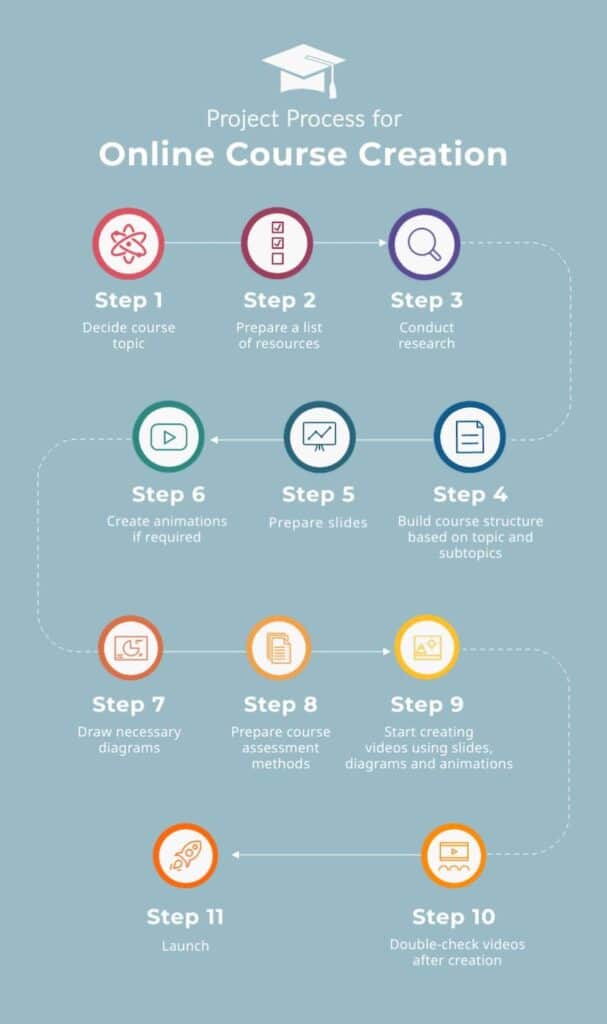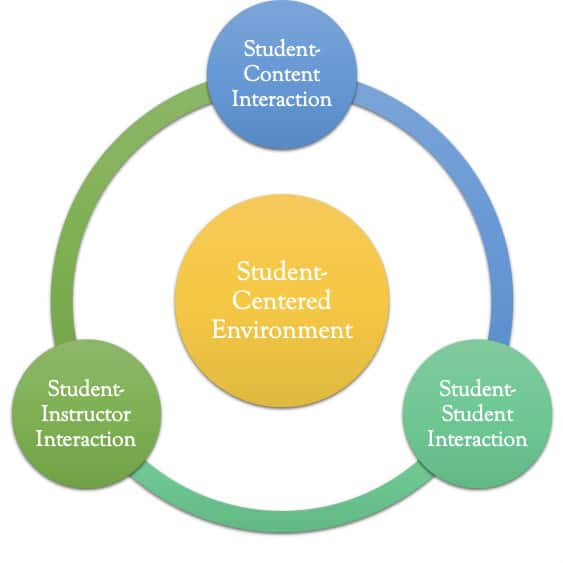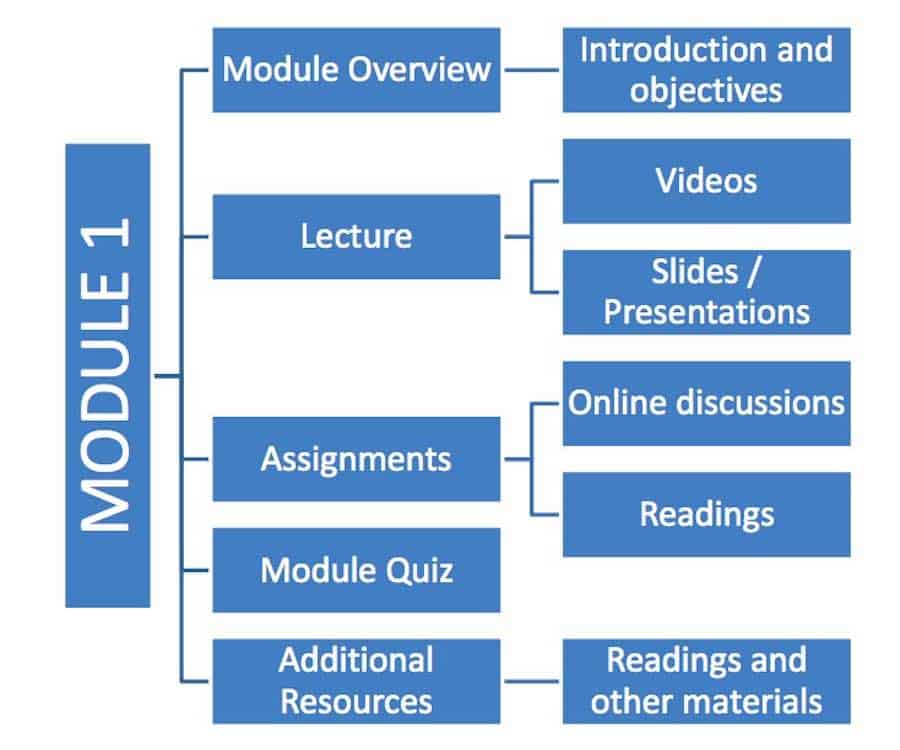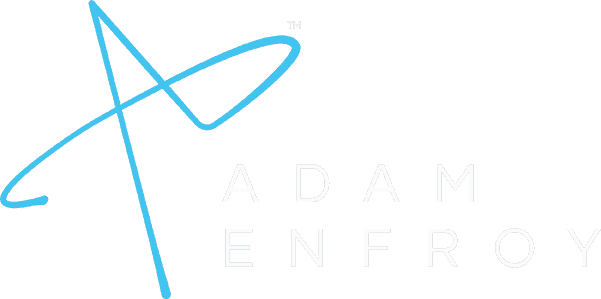How To Structure An Online Course For Maximum Engagement

Creating an online course is a challenging feat.
It requires a great deal of research, choosing the right online course platform, planning out the topics, and most importantly, dedication to ensuring it is successful.
However, you can create an engaging and effective online course with the right approach and strategy.
In this article, I will outline some essential steps you should consider when structuring your online course.
How to Structure an Online Course Successfully
Online courses are a great way to share knowledge, grow influence, and monetize expertise. But before creating content for your course, you must decide on the course content and structure.

image credit: visme.co
Online course creators with a cohesive course outline will find creating content for their courses easier.
When designing online course content for your course, it’s essential to consider the following steps.
Step One: Know Your Audience
The first step in constructing an online course is determining who you teach.
Knowing who you are targeting will help you structure the lessons and decide which topics should be covered.
Are you trying to teach beginners or advanced learners?
Are there any specific topics within your field that they need to learn?
Knowing your target audience will clarify the type of content to include in your course.

Image credit: https://www.similarweb.com/
Step Two: Provide Quality Content
Once you know your target audience, it’s time to get to the details.
People are hungry for classes taught by authentic professionals who know what they’re discussing.
Ensure that whatever information you provide is easy to understand so that users can achieve their desired transformation after taking your course.
But what does quality content mean?
Here are a few things to consider:
- Quality content should be well-written, engaging, and informative. It should provide value to the reader in some way.
- Quality content should be original and unique. The goal is to create something that stands out from similar pieces of content, not just copy what someone else has already done.
- Quality content should be relevant and timely. If the content is outdated, it won’t provide any value to readers.
- Quality content should contain accurate information. When providing facts or figures, ensure that they are verified and up-to-date.
- Quality content should contain visuals when applicable. Images, videos, and other visuals can help bring the content to life and make it more engaging for readers.
- Quality content should be optimized for search engines. This means using keywords effectively and providing helpful meta descriptions to ensure that the right people see your content.
- Quality content should be well-organized and easy to consume. Use headings, short paragraphs, and other formatting techniques to make it easier for readers to find what they want. If you’re dealing with videos or images, use alt tags and descriptions to help readers understand the content better.
Step Three: Structure Content Logically
Once you have determined the key topics and ideas, start structuring them into logical sections and lessons.
It’s essential to ensure you present each topic in an organized fashion that makes sense for new students and those with more experience with the subject matter.
Make sure each lesson builds on top of the other so that learners can progress through the material without getting confused or overwhelmed with too much information at once.
How to Make the Most of an Online Course
With the rise of virtual learning, more people than ever before are taking online courses.
Although this format has advantages, such as a more flexible schedule and no physical classroom to attend, many challenges come with online learning.
Effective communication and collaboration are essential for students and teachers to succeed online.
Here are some ideas on how to maximize the benefits of teaching online.
Encourage Student Participation Through Discussions
Creating a practical online course can be daunting, but it’s even worse if no one participates.
Creating discussion forums and encouraging questions is essential to keep students engaged and active in the system.

Image credit: https://kb.ecampus.uconn.edu/
One way to optimize student participation in an online course is to facilitate discussions through direct links at the end of each lesson that focus on specific modules.
Doing so encourages students to interact with one another while also reinforcing their understanding of a particular topic or module.
Asking questions and providing feedback in a visible space helps foster an atmosphere of advice-giving and peer-to-peer learning that can be difficult to achieve during traditional lectures or seminars.
An excellent online course can also facilitate student interaction through discussion boards or chat rooms and provide clear feedback on assignments.
Provide Technical Support Onsite
Technical help becomes more easily accessible when troubleshooting occurs in a visible space for all learners.
You can address tech issues in real time rather than having students wait for instructor responses via email or other synchronous communication.
Additionally, by providing technical support onsite, students can read through past answers about their issues.
They can also get assistance from other online class members who may have encountered similar problems and know how to solve them.
While every course should have clear learning outcomes with as few obstacles as possible on the way, supporting those who need help during class can help online students stay motivated and reach their goals.
A reference course that provides students with access to technical help, discussion boards, and clear feedback increases the chances of success for all learners.
Foster Connections Between Students & Instructors
For an online course to reach its full potential, students and instructors must develop relationships with one another despite being unable to meet face-to-face.
To help students understand the course topic better, instructors should make themselves available for questions and provide one-on-one feedback whenever possible.
Effective teaching should provide personalized attention, so creating individual lessons or assignments can help to foster these relationships.
With meaningful learning outcome objectives in place, students are also more likely to stay motivated and work hard to achieve their goals.
Award Points for Activity Completion
One way to encourage more participation in your online course is to award a point system for activity completion.
As your course idea comes to life, determine which activities could be assigned points and set a system that rewards students for completing them.
Points can be displayed so students can track their progress and compare themselves to others in the class.
Points could include completing a quiz or assignment on time, participating in class discussions, or watching lectures.
You can also assign badges or trophies when students reach certain milestones, which not only rewards them but also provides public recognition of their achievements.
Moreover, recognizing and accommodating different learning styles can come through awarding activity points.
For example, if some students prefer reading material instead of listening to a lecture or watching videos, they should be awarded the same points.
Such an incentive system encourages students to become more engaged in the course and stay motivated until the end.
Run Contests and Offer Graduation Bonuses
It’s always fun to introduce a bit of competition into the mix! Consider running contests between students – such as most active participant or best grades on an assignment – and offering prizes for the winner(s).
Depending on the topic, offering graduation bonuses could be another excellent way to reward those who complete the course.
Bonuses can include anything from discounts on future classes to free access to related materials.
Don’t Forget About Marketing And Selling
From pricing an online course, to marketing it and eventually selling it, the process can be quite overwhelming.
If you’re using an online learning platform, you’ll likely have built-in marketing and selling features, such as course descriptions, payment pages, and more.
Utilizing Technology In An Online Course
While many platforms have live scheduling features, you can always rely on tools like Zoom to host regular video conferencing sessions to add visual elements to your course.
Zoom’s Recurring Meeting feature is perfect for structuring a great online course.
It ensures security and accuracy and helps keep students from accidentally joining a system they don’t belong in!
Also, security is a significant factor when hosting an online course.
Zoom’s Recurring Meeting feature offers security features that simplify protecting your class from potential threats.
For instance, you can set up customized passwords for each meeting so that students can only join if they have the correct password.
Additionally, you can enable two-factor authentication to ensure that only authorized users can access the class materials.
Other Key Considerations
Here are some tips on structuring an online course for maximum impact.
Brainstorm Content Ideas
The first step in creating a successful online course is deciding what content to include. Brainstorm all the topics and subtopics to have in your course.
During this process, it’s helpful not to be too critical; write each idea regardless of its perceived significance.

Image credit: https://pamhendrickson.com/
Even if something seems out of place initially, there may be ways to incorporate it into the course structure later.
As you brainstorm, consider that learning styles vary from person to person. Then create content that will engage different types of learners.
When designing online courses, ensure they are engaging for visual learners by including plenty of multimedia elements, such as videos, images, and graphics.
Keeping people engaged is critical, so use social media platforms or other interactive strategies to encourage students to discuss the course material.
Organize Your Ideas Into Modules
Once you have a comprehensive list of potential topics and subtopics, it’s time to organize them into modules.

image credit: educationaltechnology.net
Ensure each module has a clear purpose and focus; this will help create cohesiveness throughout the course and ensure that all content is relevant and valuable for your students.
For starters, group similar topics together and eliminate redundancies or unnecessary details.
Many instructors create a template for each module that outlines crucial objectives, learning activities, assessments, resources, and feedback mechanisms.
If you are teaching a course in real-time, you can also include activities such as group projects and live discussion forums to help your students interact with each other and learn more engagingly.
Choose The Best Format For Course Presentation
Once your course structure is laid out, dedicate an amount of time to decide how best to present the material.
Most courses involve video lessons with related assignments and benchmarks, but this is just one approach.
Consider which format would work best for each module—video tutorials, lectures, textual instructions, webinars with live Q&A sessions, and interactive activities like quizzes or polls.
The correct course format will vary depending on the material you are teaching and the learning experience you want students to have.
Think carefully about which design will work best for your material before committing.
Also, make sure the design matches the material presented.
Consider what kind of information is most engaging for students; visuals like charts or diagrams help convey complex topics more efficiently than text alone.
As you plan your modules, remember to include other relevant resources like worksheets, ebooks, or even third-party websites that can help supplement the material.
Your course will be more comprehensive and give your students access to additional resources they may find helpful.
Making Your Course Accessible
Finally, when creating an online course, it’s essential to ensure that all learners can understand its material regardless of their age or any disabilities they may have.
You must ensure that there are:
- no barriers preventing people from accessing your course
- provide alternative versions of materials for those who cannot use specific formats
- ensure that text-based materials use simple language and sentence structure with minimal jargon or technical terms.
Creating a Dynamic Learning Environment
As an online course instructor, your goal should be to inspire and motivate your students to progress throughout the course.
To do this, you must create a dynamic learning environment that encourages engagement and offers exciting opportunities for student success.
Here are some tips on how to structure an engaging online course.
Quizzes, Exams, and Point Systems
The most effective way to encourage student engagement is by providing quizzes and exams as part of the course material.
An excellent way to motivate students is by introducing a point system that rewards points or prizes based on exam scores or module completion.
Discussion Prompts
Another great way to keep students engaged is by encouraging peer interaction through discussion prompts.
Ask them open-ended questions as part of the lesson plans that allow them to participate in meaningful conversations with one another.

Image credit: https://www.teacherspayteachers.com
Doing so will help them learn from each other and make learning more enjoyable for everyone involved.
How To Structure An Online Course – FAQ
How Can An Instructor Create An Engaging Syllabus?
Each course creation process should consider what an engaging syllabus means.
Such a syllabus will help keep students engaged throughout the course.
With an online course format, breaking down your system into manageable modules with clear objectives and goals is essential.
As a bonus, consider adding activities such as quizzes, assignments, or unique learning experiences in each module.
As you structure your online course, you can also find ways to create a dynamic learning environment.
Whether you utilize discussion boards or live Q&A sessions with the instructor, the sky’s the limit.
What Are Some Of The Best Platforms For Creating Online Courses?
Choosing a reliable online course platform is integral to launching your online course effectively.
One great choice is Kajabi, which offers all-in-one course creation and marketing tools.
Another leader in the online course market is Thinkific, which allows instructors to customize their course content with quizzes, assignments, and much more.
Why Should You Tailor Your Course Length Around A Topic?
Not every subject matter requires the same length of the course.
As a result, the online course creation process should be tailored to best fit the individual needs of your students.
A wildly successful online course meets the instructor’s and student’s needs, ensuring a positive learning process for everyone involved.
What Modules Should Be Longer or Shorter?
Your online course structure will depend on the material being taught.
Some modules may require more time to cover than others, while students can complete other topics in far less time.
With course content, it’s best to keep modules short, ensuring that online students can meet them promptly.
What Features Come With The Majority Of Online Course Platforms?
It all depends on the platform you choose.
Some platforms offer basic features like course creation and hosting, while others include podcasts, video streaming services, and live online events.
Wrap Up.
As an infopreneur, one of the most critical steps in creating a successful online course is structuring your content effectively.
Doing so allows students to absorb and apply information quickly.
Brainstorming ideas and organizing them into modules can help ensure each topic has a purpose within the framework.
Finally, selecting the correct format for presentation will make learning more accessible by providing students with multiple avenues for absorbing information quickly and effectively.
Considering all the steps above, you’ll be well on your way to building a profitable online education business that helps others learn and grow.
Further reading on AdamEnfroy.com: Skool is a platform that many course creators are moving towards.
With its simple interface, it makes creating an online course a breeze.
It allows you to easily create modules with text, images, and audio recordings that can be downloaded as PDFs or listened to on any device.
Moreover, here are the top blogging courses that can give you ideas on how to properly structure and design your content.
Last Updated on May 8, 2024 by Adam Enfroy
